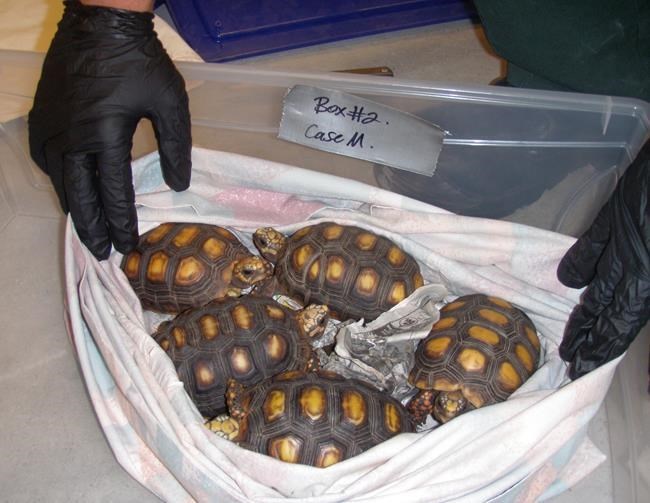
Red-Footed Tortoises are shown in a handout photo from Environment Canada of animals which they have seized. THE CANADIAN PRESS/HO-Environment Canada MANDATORY CREDIT
October 04, 2016 - 8:04 AM
TORONTO - How do exotic animals go from living in the wild to sitting in a cage or tank in someone's living room halfway around the world? Rosemary Collard, an assistant professor of geography at Montreal's Concordia University, spent four years investigating the trade in live exotic animals, travelling to the Maya forest region to research animal capture, to exotic animal auctions in the U.S. and to animal rehabilitation centres in Guatemala and British Columbia. She spoke about her work with The Canadian Press.
———
Q — Can you give me an idea of the size and scope of the exotic animal trade? I guess it's mostly black market, right?
A — It depends on whose estimates you listen to. But it's thought to be at least multiple billions a year, basically these massive flows of money and animals zooming around the world as we speak. Because so much of the trade, even the legal trade, so much of it is clandestine in a lot of cases, or the legality is ambiguous. And you have to be a real expert to even tell whether a species is labelled properly as it's crossing borders. It makes it this incredibly murky economy.
Q — How does this actually happen?
A — Some species are almost all captive-bred, like a lot of reptiles now are captive-bred. So people are not necessarily going out into the forest and capturing animals. But that still does happen a lot, and the crazy statistic is that the billions of animals imported into the U.S. in the last few years, about 80 per cent of those were captured from wild populations. In that case it's done from what I learned on a pretty decentralized basis. They would be people who would not be working full time in the exotic pet trade necessarily, they would have other jobs that would take them in the forest. But it's happening on a basis where one person would catch one or two parrots and then you would have a middleman or a middlewoman going from small village to small village collecting the animals and bringing them to market. And that's probably not the same the person who would be taking them across the border. They would either be sold to a market or an international distributor who would take them across the border, usually in a truck but also by ship or by air.
Q — What are their motivations?
A — You'll hear a lot of rhetoric internationally about wildlife trade as a sustainable development mechanism, that it can be done in a way that brings revenue to the local communities, because trade tends to flow between biodiversity-rich but capital-poor areas to capital-rich areas, so from parts of Africa to the E.U. or something. But very few studies have shown that that happens. What I found out in my research, at least in the case of Mexico, Guatemala and Belize, is that the people who are capturing the animals and who are by far the poorest of anyone involved in this chain are making by far the least amount of money. There's enough financial incentive to sell a parrot that people will do it — selling a parrot to a middleman might bring as much as a few months' income for a farmer — but that middleman turns and sells that bird for far more money.
Q — You talk about the commodification of animals. What makes them valued by the average person and who wants exotics?
A- At animal auctions, there would be these very distinct groups of people — wealthier ranch owners would be buying zebras, camels giraffes for use on private ranches where they offer a sort of safari experience without having to leave the U.S. Then you have people buying snakes and reptiles and there's more of an element of danger involved. And then you have private pet owners who are more interested in the cuddly creatures. And then there's a lot of petting zoos. But the thing I observed at the auction was that docility, individuality and rarity were the things that were emphasized the most continuously and really did seem to bump up the price.
Q — So what do you think needs to be done? Do you think there's a way to regulate it differently to minimize that kind of trade?
A — There was a study a few years ago that showed that bans can actually encourage trade in some cases because an international ban on trade is an indication of an animal becoming more and more scarce, which increases its value, which makes it more desirable to capture and trade. But I think one of things about law is it's not just implemented for a concrete effect necessarily but also to say something about a society's moral or ethical position. For me, the way that animals currently are really only registrable as property under the law is something that is a very structural obstacle to implementing better laws to protect animals. I think in the meantime, before more broad scope change can happen, that exotic pets should not be allowed.
News from © The Canadian Press, 2016